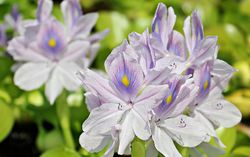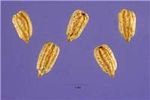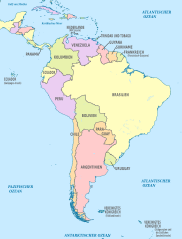Common water hyacinth
| Common water hyacinth |
|---|

|
| Scientific Classification |
|
| Scientific Name |
|
Eichhornia crassipes |
| Up-close picture of the Water Hyacinth's flower |
The common water hyacinth is a species of water hyacinth known by the scientific name Eichhornia crassipes. It is an invasive plant native to Brazil that freely floats on the surface of freshwater lakes and ponds. It grows and reproduces rapidly, causing it to spread across bodies of water, covering it in a thick layer of growth called a mat. These mats can cause serious problems for organisms in and around the afflicted area such as blocking transportation and removing a potential food source. [2]
One of the most amazing abilities of this species is the near inability ever to be eradicated once introduced in a location. In Florida for example, even with certain waterways receiving daily attention from workers, the water hyacinth finds ways to stay alive.[3] The plant has been declared a "noxious weed" and in some areas of the world such as Fiji, it is illegal to grow one even in an enclosed pond. The water hyacinth is a threat to the livelihoods of many people and is being treated world-round as a danger. [4]
Body Design
Eichhornia crassipes[Water hyacinth] :they grow in Water, the petioles are hollow, so they can float to the surface. So people call them water hyacinth.[5]
Water hyacinth leaves are round or wide rhombus, with dark green and dark green leaves. The leaves are rounded or slightly pointed at the top. The base of the leaves is round。[6]
The water hyacinth root is developed, the stem is very short, the petiole is different length; The style is about two centimeters long. Height 30-60 cm, 30 cm long; Generally, there will be 5-10 leaves, which are 4.5 to 14.5cm long and 5-14 cm wide.[7]
The flower is protruding from the base of the petiole, which is about 34-46 cm long and usually has 9-12 flowers. The flowers are divided into 6 pieces, petals, and violet blue.[8]
Life Cycle
The water hyacinth (Eichhornia crassipes) reproduces both asexually and sexually.[3] It produces a massive amount of seeds. Just one single plant can produce up to 5,000 seeds. These seeds remain ready for germination for 15-20 years and can live atop the hyacinth mats (layers of hyacinth tissue on the surface of water) or underwater until they germinate. [2] Birds, wind, and waves carry seeds and even fully grown plants into new areas, where it generates a mat of its own.[9]
The primary problem is not the seeds, but the asexual reproduction that the water hyacinth is capable of. Its stolons are easily broken off by wind and waves, which then rapidly form new mats.[3] Each hyacinth can also produce daughter plants, which are connected to the parent plant via runners underwater. [4]This allows even a single plant the size of a human hand to cover more than 6,500 square feet of open water in a thick mat in one growing season in California. [10]
The flowers bloom from early spring to late fall in harsher climates, but in temperate regions they flower year-round. In tropical areas the flowers produce double the amount of seeds as those in temperate conditions.[3] Once the flower has matured, the seeds are then released below water.[4]ref name=Bugwood-Wiki>Batcher, M. Eichhornia crassipes Bugwood Wiki. Web. Last modified March 10, 2015. </ref>
Ecology
The common water Hyacinth is indigenous to south America. [11] The Water Hyacinth is found only in watery areas and survives off of the minerals found in the water as many plants do. [12] It grows in warm conditions up 95 degrees, but it’s most efficient growth occurs between 77 degrees and 86 degrees Fahrenheit. The water hyacinth is a freshwater plant only; it can not live in areas with high salinity such as salt water.[13]
The hyacinth becomes invasive because of its place in the food chain;it’s only natural predators are weevils.[14].Weevils must be present where they grow to prevent them from being invasive, but weevils can also be harmful to their surroundings [15] The Water Hyacinth cuts off and destroys the food web causing the death of many organisms. It also destroys ecosystems they come in contact to other than the Amazon basin located in South America.[16]
Three parts of the ecology of the Common Water Hyacinth are the reproduction,formation of seeds and mats. The Water Hyacinth uses two types of reproduction; vegetative and sexual. Under the correct conditions (mentioned above) the reproduction takes place quickly, and therefore can become invasive very fast. For seeds to germinate, they need certain conditions to be satisfied that are unique to each. During the formation of the mats, growing takes place in the plant overall (getting larger) and especially in the root. The Water Hyacinth either ceases or increases in producing daughter plants during these periods of time based on the density of the ecosystem. [17]
Invasive Species
Location and Method of Introduction
Eichhornia crassipes is the origin of South America in the Brazilian amazon, in Brazil they stabbed predators with biological control, so just a kind of ornamental plants distributed in the water, in the 19th century Eichhornia crassipes cultivation as ornamental plant rice in Asia, Africa, Europe and North America and other dozens of countries, 1901 Eichhornia crassipes as flowers to China, because of its extremely fast asexual reproduction, are widely distributed in north China, east China, central China, south China and southwest China and other 19 cities and provinces.
Environmental Impact
As you can imagine, the Water Hyacinth can become a major problem to the environments it comes in contact to. It negatively affects the usage of the water (transportation, irrigation, etc.), fishing industries, and restricts the water flow.The Water Hyacinth destroys the cleanliness of the bodies of water it invades, making the water unusable in most cases. As it takes over the area, it depletes the oxygen levels needed in the water causing the population of fish to decline. The decline of the fish population means the deterioration of the fishing industries.[4]
Control Methods
One of the most common way to control the growth of the water hyacinth is to use mechanical grinders that float on the top of the water. They have a conveyor belt on the front and a grinding machine behind that, so they can clear massive areas of mats very quickly. Another tried and true method of control is the use of a chemical called 2,4-D. It is an herbicide that is used commonly to kill weeds. This chemical is able to kill these plants in 2-4 weeks. Usually, the plants regrow in a few months or even sooner if the weather conditions are unfavorable. If the weather is warm and humid, 2,4-D is more effective, but if the conditions are cooler the plants have a chance to grow back at a higher rate.[4]
Video
A brief overview of the water hyacinth.
References
- ↑ Classification USDA. Web. Author Unknown November 13, 2017. (accessed)
- ↑ 2.0 2.1 Batcher, M. Eichhornia crassipes Bugwood Wiki. Web. Last modified March 10, 2015.
- ↑ 3.0 3.1 3.2 3.3 Masterson, J. Eichhornia Crassipes Smithsonian Marine Station. Web. Last Updated June 30, 2006.
- ↑ 4.0 4.1 4.2 4.3 4.4 Eichhornia crassipes CABI. Web. Author unknown. Last updated October 11, 2017.
- ↑ Authorlastname, Firstname. Eichhornia crassipesWikipedia. Web.last modified october 29, 2017.
- ↑ "Center for Aquatic and Invasive Plants, University of Florida". Eichhornia crassipesUniversity of Florida. Web.specify whether date is the of publication June 2001.
- ↑ Authorlastname, Firstname. 凤眼蓝 baidubaike. Web.last modified date January 16, 2016.
- ↑ Authorlastname, Firstname. 水葫芦 hudongkaike. Web.last modified date September 12, 2017.
- ↑ Non-native Invasive Freshwater Plants Department of Ecology State of Washington. Web. Author unknown. Accessed November 5, 2017.
- ↑ Clarke, Chris. Invasive Species Week: The Water HyacinthKCET. Web. Published August 8, 2014.
- ↑ invasive-plantinvasive-plant.web. Author Unknown November 4,2017 (accessed)
- ↑ invasive-plantWater Hyacinth. web. Last Accessed November 4, 2017.
- ↑ Eichornia-CrassapiesEichornia Crassapies.web. Author Unknown. November,4,2017 (accessed)
- ↑ Kibret, Solomon. invasive plantThe Conversation.web. September 4, 2017 (Last updated)
- ↑ Brunet,Donna.weevils web. November 4, 2017 (accessed)
- ↑ Kibret, Solomon. invasive plant The Conversation. web. Last Updated September 4, 2017.
- ↑ Batcher, Michael, Global Invasive Species team, The Nature Conservancy. Eichhornia_crassipes_ecology Bugwoodwiki.web. November 6, 2017 accessed



